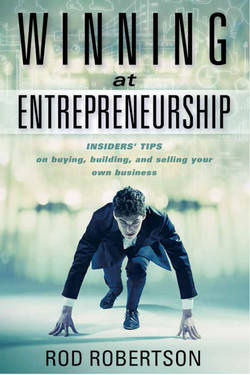Читать книгу Winning at Entrepreneurship - Rod Robertson - Страница 15
На сайте Литреса книга снята с продажи.
ОглавлениеChapter 5
START, BUY, OR FRANCHISE?
PICK YOUR POISON!
Consider these questions before you make the leap into business ownership. Then we’ll discuss, in general here and in more detail in later chapters, their implications to a successful venture.
How much cash do you have?
Do you have access to cash from family and friends?
Do you have good credit and a good financial track record?
What does your bio look like?
Are you networked in this sector?
Can you carry yourself and/or your family financially for a year?
Is your skill set in this arena?
Who comprises your network of advisors?
Do you have banking relationships?
Are you judgment proof?
Are you willing to sign personally with a bank?
Is your spouse or significant other behind you?
How are you presenting yourself to the arena?
Are you schooled in mergers and acquisitions?
For how long do you want to do this?
Do you have the physical stamina and well-being to deal with the stress?
Have you assessed your strengths and weaknesses as an operator?
Judgment proof: in regard to an individual’s personal assets, protected and sheltered from creditors.
OPTION A: START YOUR OWN BUSINESS
To start a business, you must have expertise in that industry. To try to parachute into a new world with a new concept will most certainly lead to a painful and inglorious end. You most likely will be plucked liked the proverbial chicken by your new “friends” in the industry if you don’t have ground-breaking technology or have a location, distribution, or strategic partnership angle to pursue. If you are low on funds and do not have access to cash, then bootstrapping a startup may be the only way to go if you are determined to become an entrepreneur. The path will be long and painful, but keep an eye peeled for any possible play to make a joint venture, sell through existing channels, or piggyback on more mature organizations to gather momentum. (See Chapter 8, “Start-ups.”)
Joint venture: two companies working together to achieve goals.
OPTION B: BUY AN EXISTING ENTERPRISE
To buy an existing business, you should have financial resources in excess of $250,000 and the capability to lay in additional funds equal to approximately 50 percent of your down payment amount for working capital (after the close) before you start. You should also have the ability to go without a salary for at least six months; this should make you a reasonably qualified candidate to buy an operating business. This three-headed hydra of cash down, cash to carry, and no salary is a true litmus test. Running out of cash after purchase is the most overlooked stumbling block to building a successful business. Very few businesses allow the new owner to step into a smoothly running machine and pull down a $125,000 per annum salary to start. (See Chapter 9, “Buying an Existing Business.”)
Working capital: money available to run a business on a daily basis.
OPTION C: PURCHASING A FRANCHISE
Often overlooked (for good reason!) is the option to purchase a franchise. There are literally hundreds of fascinating options to consider. However, franchising is an industry full of pitfalls and endless fees, as you are tethered to the franchisor and dependent upon a corporation that is supplying you with knowledge, know-how, and a road map to success. Considering the risk factor and money needed, it is a compromise solution between a start-up and buying an enterprise as outlined above. As the franchise’s “proof of concept” has been supposedly laid out for you and your path to success defined by prior franchisee successes, many of the vagaries of expansion and its inherent risk have been allayed. You have a step-by-step process to follow and a cadre of experienced and successful franchisors who will steer you to victory.
Franchise: a contract between a company and a franchisee to operate a business under the company’s name and often guidance for a fee; for example, McDonald’s.
Franchisee: buyer of a franchise.
Franchisor: a company that sells franchises of its business.
But why, then, do 75 percent of franchisees end in dissatisfaction and dismay, as well as financial ruin? Running with the thundering herd of franchisees has great comfort, especially for the first-time buyer, but your upside is also usually limited. Your exit strategy and “cashing out” are often confined by the very people that sold you your business or are other franchisees. In the end, most buyers of franchises are disappointed at the net results of a sale of their enterprise, but they had much less risk to endure during their ownership cycle.
However, you may very well secure a spot in that 25 percent of franchisees that succeed with a solid game plan laid out by others. See Chapter 12, “Buying a Franchise,” to increase your odds if you feel this is the route for you.
